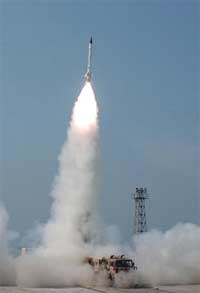India tests ‘Swordfish’ radar with successful missile defence test
06 Mar 2009
New Delhi: In a third successful test of its ambitious missile defence programme, Defence Research and Development Orgainsation (DRDO) scientists launched an indigenously developed interceptor missile that destroyed an incoming ballistic "enemy" missile at an altitude of 75 km. The missile firing will have also tested long-range capabilities of its indigenously developed Swordfish radar.
 As part of the test, an 'enemy' missile was fired from a naval ship in the Bay of Bengal simulating the terminal phase of the flight of a ballistic missile with a range of 1,500 km. As the incoming missile neared the Wheeler Island off the Orissa coast, a Prithvi air defence missile was launched to intercept the 'enemy' missile at an altitude of about 75 km and 'killed' it, an official said.
As part of the test, an 'enemy' missile was fired from a naval ship in the Bay of Bengal simulating the terminal phase of the flight of a ballistic missile with a range of 1,500 km. As the incoming missile neared the Wheeler Island off the Orissa coast, a Prithvi air defence missile was launched to intercept the 'enemy' missile at an altitude of about 75 km and 'killed' it, an official said.
The 'enemy' missile was a modified Dhanush surface-to-surface missile (SSM), which is the ship-borne, naval version of the Prithvi SSM. The Dhanush attained an altitude of 120 km in a bid to mimic the terminal phase of IRBMs currently deployed with hostile neighbours. It was fired from a ship 100 km away from the coast.
The two-stage interceptor was launched from a mobile launcher at the Wheeler Island complex.
This was the third BMD test in the series and would have involved testing the indigenously developed "Swordfish" long-range tracking radar. The ''Swordfish is an acknowledged derivative of the Israeli Green Pine long range radar, which is the critical component of that country's Arrow missile defence system.
India had earlier imported two of these Israeli radars for its own use.
Earlier, in January, DRDO sources had said that a third test of the missile defence shield would involve both interceptor missiles and missile tracking radars.
While two earlier tests, in November 2006 and December 2007, successfully tested the Prithvi Air Defence (PAD -exo-atmospheric at 48 km altitude and the Advanced Air Defence (AAD-endo-atmospheric) interceptor system at 15 km altitude, the main thrust of the forthcoming tests would have been to validate the capabilities of the indigenously developed 'Swordfish' Long Range Tracking Radar (LRTR).
Swordfish is a target-acquisition and fire-control radar designed for the country's missile defence system.
"The missile to be hit will be fired from a longer distance than it was in the earlier test. DRDO will test whether the radar can track the incoming missile from that distance or not," officials had said in January.
The radar will be instrumental in tracking an incoming hostile missile which will be intercepted by the PAD exo-atmospheric interceptor missile at an altitude over 75 km from earth, defence sources had said.
The programme is aimed at providing the country with a credible missile defence shield – primarily against missiles fielded by hostile neighbours Pakistan and China.
The Pakistani Hatf and Ghauri missiles, essentially hand-me-down versions of Chinese and North Korean missiles, have been touted as being India-specific. These tests are meant to simulate trajectories of these family of missiles.
Yesterday scientists had said that the 'enemy' missile would be a modified version of the Dhanush surface-to-surface missile and would simulate the terminal phase of the flight of a ballistic missile with a range of 1,500 km, similar to Pakistan's Ghauri missile.
"As the incoming missile nears Wheeler Island, a Prithvi air defence missile will be launched to intercept it at an altitude of about 80 km and kill it," the official added.
Scientists had also indicated yesterday that DRDO would need to carry out at least three to four further trials with both the endo and exo-atmospheric versions of the missile shield before declaring it operational.
"The test will mark the completion of the first phase of the programme and it will secure operational clearance by 2012-13," a scientist said.
Interestingly, though baptised as the Prithvi Air Defence system, the interceptor has now been renamed Pradyumna.
DRDO has affirmed that its system would be superior to the Russian S-300 and the American Patriot systems, both of which systems have been offered to India by its manufacturers.
The missile interception trial was witnessed by the DRDO chief M Natarajan, Air Defence Programme director Dr VK Saraswat, senior scientists from DRDO, senior officers from armed forces and government officials.(See: India gears up for next round of Ballistic Missile Defence tests)













.jpg)






.jpg)









